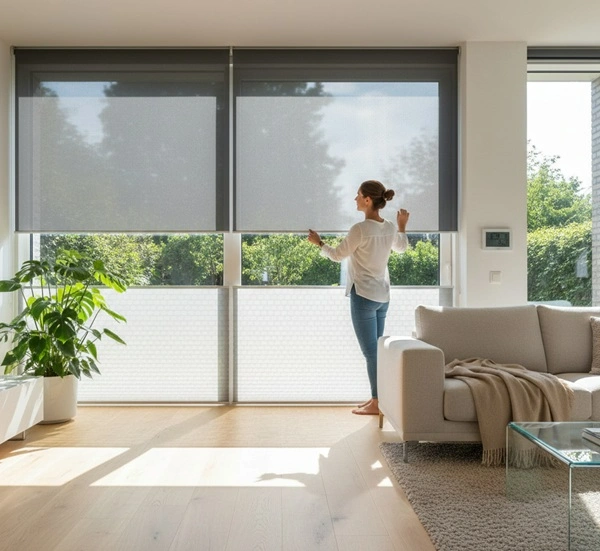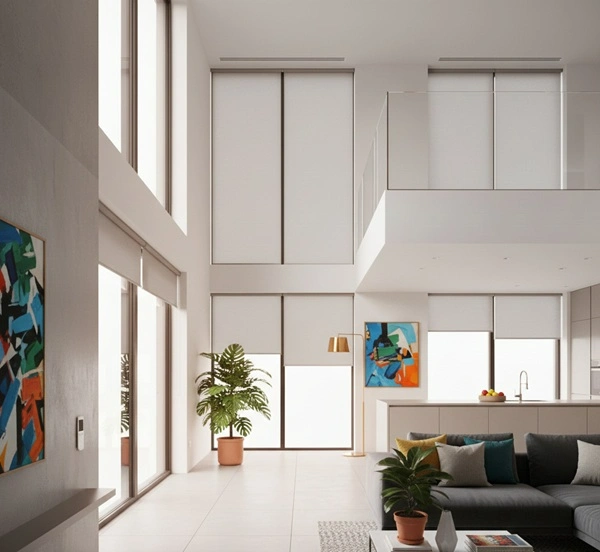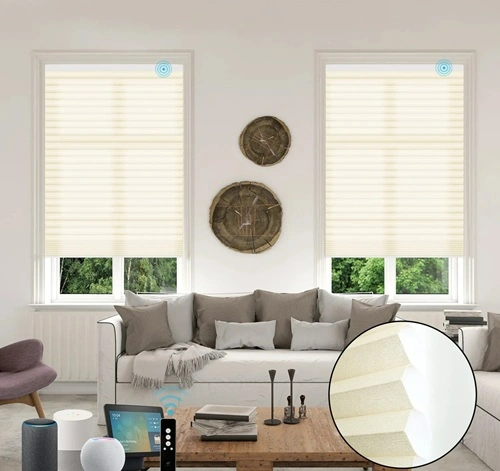
Choosing the right window blinds for your living room isn’t merely a matter of picking something that looks good. The living room is often the heart of your home: it’s where you relax, entertain, and spend quality time with family. The blinds you choose will affect not just the feel of the space, but also light, privacy, energy efficiency, and long-term comfort.
In this guide, we’ll walk you through how to choose window blinds for your living room like a pro. From types of blinds to material choices, practical tips, and common mistakes — you’ll be equipped to make a decision that’s both beautiful and functional. Let’s dive in.
1. Why Your Choice of Blinds Matters in the Living Room
-
Light Control & Ambience: Depending on your living room orientation and how much sunlight it gets, blinds can help you control glare, soften natural light, or block it out entirely.
-
Privacy: A living room often faces the street or neighbors. The right blinds can give you daytime light and nighttime privacy.
-
Energy Efficiency: Certain blinds insulate your windows; they can help reduce heating in winter or block heat in summer, saving energy costs.
-
Style & Aesthetic: Blinds contribute significantly to your decor. Whether your style is modern, classic, minimalist, or boho, there’s a blind to match.
-
Maintenance & Longevity: The right material will wear better, require less cleaning, and survive daily use more comfortably.
2. Key Things to Consider Before Buying
Before you even choose a style, here are critical factors to think through to make sure your window blinds for the living room serve you well.
2.1 Measure Accurately
-
Use a steel measuring tape to get the precise height and width of your window.
-
Decide on mounting style — inside the frame (clean, flush look) or outside the frame (more coverage, blocks better).
-
Account for window handles, trim, or any obstructions that could affect blind operation.
2.2 Define Your Light & Privacy Needs
-
Do you want to filter light or block it completely? Sheer or light-filtering blinds allow natural light, while darker or blackout options give full privacy.
-
Think about where your living room windows face — if it’s a busy street or neighboring building, privacy becomes more important.
-
Consider if you want adjustable light control, for example, slats you can tilt (Venetian, vertical) vs fixed fabric blinds.
2.3 Material & Durability
Different materials have different benefits:
-
Wood: Warm, natural, classic.
-
Faux Wood / PVC: Moisture-resistant, durable, budget-friendly.
-
Metal / Aluminum: Sleek, modern, often lightweight.
-
Fabric (Roman, roller, pleated): Soft, customizable, but may require more cleaning.
-
Cellular (Honeycomb): Great for insulation; traps air to improve energy efficiency.
-
Solar / UV-filtering shades: Filter harsh sunlight, reduce glare, protect furniture.
2.4 Style & Color Coordination
-
Tone should either blend with the room or provide a deliberate contrast. Neutral colors (whites, grays, taupes) are safe and timeless.
-
Consider texture — woven blinds, linen fabrics, or wood slats can add visual interest.
-
For flow between rooms, maintain a consistent color family in blinds across the house.
2.5 Energy Efficiency
-
Use blinds with insulating properties, like cellular shades, to help with temperature regulation.
-
Reflective fabrics or lighter-colored blinds can help reflect heat in summer.
-
Some blinds help reduce UV exposure to furniture and floors.
2.6 Maintenance & Safety
-
How much effort do you want to put into cleaning? Metal or faux wood blinds are easier to wipe; fabrics may need vacuuming or dry-cleaning.
-
If you have kids or pets, consider cordless or motorized blinds to avoid hanging cord hazards.
-
Think about how often you want to replace or refresh your blinds. Durable materials may cost more upfront but save in the long run.
2.7 Budget
-
Blinds range widely in price. According to a study, metal blinds might cost around USD 43–106, faux wood around USD 84–120, and real wood up to USD 150+.
-
Consider quality vs cost: investing in good material and measurement saves money on replacements and inefficiencies.
3. Popular Types of Window Blinds for Living Rooms

Different types of blinds suit different needs. Here are some of the most common and why you might pick them for your living room:
| Blind Type | Best For / Strengths in Living Room |
|---|---|
| Venetian Blinds (Wood / Aluminum) | Precise light control via tilting slats; classic and versatile. |
| Vertical Blinds | Large windows, sliding doors; easy to operate and control light. |
| Roller Blinds | Minimalist, modern look; available in blackout or light-filtering fabrics. |
| Roman Blinds | Soft, fabric folds; can be sheers or blackout; adds a touch of elegance. |
| Cellular / Honeycomb Blinds | Excellent insulation; energy-efficient. |
| Solar Shades | Blocks UV, reduces glare, but maintains view. |
| Zebra / Day-Night Blinds | Alternate sheer and solid stripes for flexible privacy and light control. |
4. Step-by-Step Guide to Choosing Your Living Room Blinds
Here is a structured, actionable guide you can follow when picking blinds:
-
Set Your Objectives
-
Decide what you want your blinds to do: filter light, block heat, improve insulation, give privacy, etc.
-
Write down your must-haves (e.g., blackout, cordless, remote control).
-
-
Measure Your Windows
-
Measure width and height precisely.
-
Decide on mounting type (inside or outside).
-
Take note of obstructions (handles, trims).
-
-
Choose Material Based on Use
-
For insulation: cellular.
-
For design: wood, woven, linen.
-
For durability and easy cleaning: faux wood or aluminum.
-
For UV protection: solar shades.
-
-
Pick a Style That Matches Your Decor
-
Look at your furniture, wall color, floor.
-
Choose a blind style and color that harmonizes.
-
-
Decide on Operation Mechanism
-
Manual cord or wand.
-
Cordless (safer for kids/pets).
-
Motorized (for convenience or hard-to-reach windows).
-
-
Order Fabric Swatches or Samples
-
See how colors and textures look in your light.
-
Avoid surprises; swatches help you test in real-life conditions.
-
-
Layer (If Needed)
-
Consider pairing blinds with curtains for style and function.
-
For example: blackout roller blind + sheers for daytime softness.
-
-
Budget & Order
-
Balance budget with quality.
-
Consider custom vs ready-made.
-
Measure again before ordering to avoid mistakes.
-
-
Install Properly
-
Use correct brackets for inside or outside mount.
-
Ensure smooth, secure operation.
-
-
Maintain Your Blinds
-
Dust regularly.
-
Clean materials according to their care needs.
-
Check mechanisms periodically (cords, motors, etc.).
-
5. Real-Life Examples & Case Studies
Case Study 1: Bright Sun-Facing Living Room
Problem: A homeowner has a living room with large windows facing west. The room gets blistering afternoon sun, causing glare and heat.
Solution: She opts for solar shades with a 3% openness fabric — this blocks most UV, reduces heat, and still lets her enjoy natural light. To improve insulation in winter, she pairs these with cellular blinds layered underneath. This combo helps regulate temperature throughout the year.

Case Study 2: Cozy, Traditional Living Room
Problem: A homeowner wants to add a warm, homey feel to a classic-style living room with wooden furniture but is struggling with harsh light in the morning.
Solution: He installs wooden Venetian blinds. The slats match his furniture, and he can tilt them to just soften the light in the morning.
At night, he closes them completely for privacy but doesn’t go for blackout — he prefers a little ambient glow.

Case Study 3: Modern, Minimalist Open-Plan Space
Problem: The homeowner wants something sleek that doesn’t interrupt the clean lines of their open-plan living space.
Solution: They choose roller blinds in a neutral tone, mounted inside the frame for a flush finish.
Additionally, for their tall windows, they pick motorized operation — so they can control the blinds with a remote without compromising the minimalist aesthetic.

6. Common Mistakes & Pitfalls to Avoid
-
Wrong Measurements
Many people “eyeball” or don’t measure precisely, leading to blinds that don’t fit well. -
Ignoring Material Trade-offs
Choosing a pretty but delicate fabric without thinking about cleaning needs or durability. -
Overlooking Energy Efficiency
Not considering how blinds can insulate or reflect heat — missing out on long-term savings. -
Neglecting Safety
Hanging corded blinds in homes with children or pets — risk of entanglement. -
Skipping Swatches
Picking colors from photos or online without testing real fabric swatches can lead to mismatches. -
Ignoring Style Harmony
Blinds that clash with the room’s decor or overwhelm other design elements. -
Not Considering Maintenance
Forgetting that certain materials accumulate dust faster or need special cleaning.
-
.
Transform your living space with Smart Wings Home
Smartwings innovative design meets effortless style from chic furniture to smart home essentials; every piece is crafted to elevate comfort and functionality. Make your house feel like a dream home with products that combine quality, elegance, and practicality. Explore smartwingshome.com today and give your home the upgrade it deserves.
7. Seasonal & Lifestyle Considerations
-
Summer (Hot, Sunny Months):
-
Tilt slats upward to reflect heat outward.
-
Use solar or light-filtering blinds to cut UV without darkening the room completely.
-
Consider reflective or insulated blinds (cellular) to keep your living room cool.
-
-
Winter (Cold Months):
-
Close blinds fully at night to trap warm air with insulating blinds.
-
Use cellular blinds to reduce heat loss and save on heating.
-
-
Entertainment Mode:
-
For movie nights, blackout roller blinds or Roman blinds provide the darkness needed.
-
Layer with sheer blinds or curtains for daytime flexibility.
-
-
Everyday Family Use:
-
If you have kids or pets, go for cordless or motorized blinds for safety.
-
Choose materials that can handle wear, dust, and cleaning — faux wood or aluminum work well.
-
8. Frequently Asked Questions (FAQ)
Q1: Should I choose blinds or curtains — or both?
-
Blinds offer precise light control, insulation, and a clean look. Curtains add softness and style. Many designers recommend layering blinds with curtains for both function and aesthetics.
Q2: Are motorized blinds worth the cost?
-
If you have large windows, high windows, or want a sleek, cord-free look, motorized blinds are very convenient. They also increase safety if children are around.
Q3: What’s better for insulation: blinds or other treatments?
-
Cellular (honeycomb) blinds are among the best for insulation because they trap air.
-
Layering blinds with thermal curtains can further improve insulation.
Q4: How often do I need to clean my blinds?
-
It depends on material: metal or faux wood can be wiped weekly; fabric blinds might need vacuuming monthly or occasional deeper cleaning.
Q5: Can blinds prevent furniture from fading due to sunlight?
-
Yes. Solar blinds and UV-filtering blinds help block harmful UV rays that fade fabrics and flooring.
9. Recommended Window Blinds for Living Room: Sample Products
Here are some real-world options you can consider for your living room. These cover different styles and needs:
SmartWings Motorized Cellular Shades
Price: Usually $120–$250 depending on size and smart-home features
Rating: Approx. 4.7
Merchants: SmartWings, Amazon, smart-home retailers

A top-tier choice for anyone wanting convenience and smart-home integration. These cellular shades offer excellent energy efficiency, cordless safety, and compatibility with Alexa, Google Home, and Apple automation systems.
FÖNSTERBLAD Black-out Roller Blind
Price: Around $15–$20
Number of Reviews: 843
Rating: 3.9
Merchants: IKEA (U.S.)
A budget-friendly blackout roller blind that provides simple light blocking for small to medium windows. Best for renters or anyone wanting an affordable upgrade.
FRIDANS Black-out Roller Blind
Price: About $25–$35
Number of Reviews: 5500
Rating: 4.1
Merchants: IKEA (U.S.)
Known for its smoother pull mechanism and wider size options, this roller blind offers dependable privacy and room-darkening performance.
TRETUR Black-out Roller Blind
Price: Typically $45–$70 depending on size
Number of Reviews: 1700
Rating: 4.3
Merchants: IKEA (U.S.)
A premium-grade blackout blind with a quieter, cordless design and better opacity — excellent for living rooms where glare control is important.
TRIPPEVALS Black-out Cellular Blind
Price: Ranges from $60–$90
Number of Reviews: 600
Rating: 4.1
Merchants: IKEA (U.S.)
A honeycomb-style blind designed for thermal performance, helping keep your living room cooler in summer and warmer in winter.
Linen Zebra Semi-Blackout Blinds
Price: Typically $40–$80
Merchants: Amazon, home-improvement stores
Features alternating sheer and solid stripes, giving you excellent control over light levels and maintaining a modern aesthetic.
Conclusion
Choosing the perfect window blinds for living room isn’t just a design exercise — it’s a balance of aesthetics, function, comfort, and efficiency. By carefully considering your light and privacy needs, measuring precisely, selecting the right material, and planning for how you will use and maintain the blinds, you’ll make a decision that improves both how your room looks and how it feels.
Start by clarifying what matters most to you — is it energy savings, maximum blackout, or a layered, stylish effect? Then follow a step-by-step guide to narrow down your options, order samples, and pick something that seamlessly fits into your life. With the right blinds, your living room becomes a more comfortable, beautiful, and functional space.


